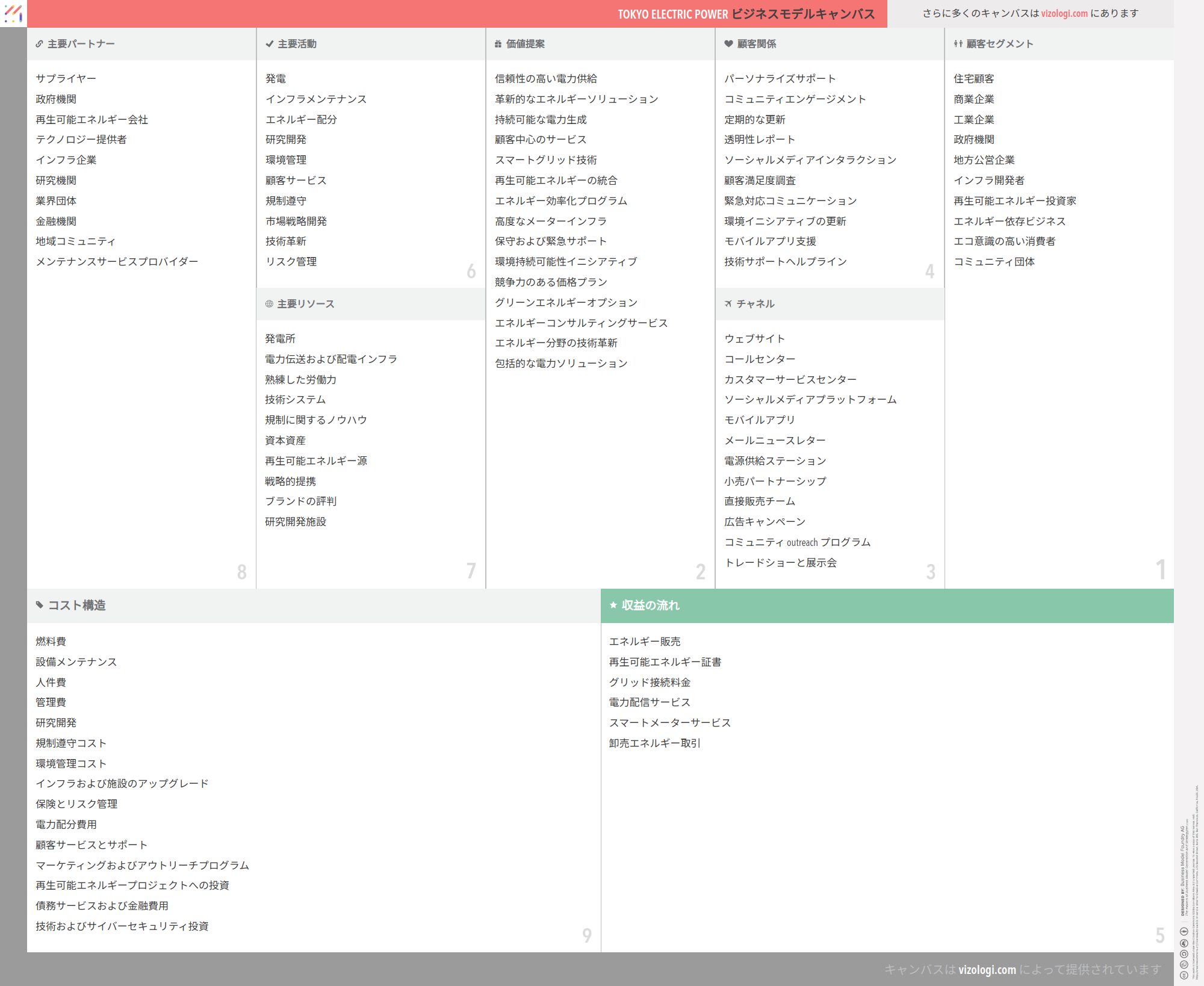Why Tokyo Electric Power's Business Model is so successful?
Get all the answers 
Tokyo Electric Power’s Company Overview
東京電力ホールディングス株式会社(TEPCO)は、日本の主要な電力会社およびエネルギーソリューションプロバイダーです。安定した電力供給を確保し、カーボンニュートラル社会の実現に貢献することを使命とし、TEPCOは燃料・電力、電力グリッド、顧客サービス、企業、情報・通信を含むいくつかの部門を通じて運営されています。同社の包括的なサービス提供は、火力、 hydropower、再生可能エネルギー発電を網羅し、多様で強靭なエネルギー供給を確保します。TEPCOは持続可能性に深くコミットしており、カーボン排出を削減し、供給および消費におけるエネルギー効率を促進するために最先端の技術とインフラに投資しています。
TEPCOの独自のビジネスモデルは、異なるセグメントにわたる垂直統合運営によって特徴づけられています。燃料・電力部門は、火力発電、燃料調達、および燃料関連事業への投資に注力しています。電力グリッド部門は、電気の送電、変電所、分配を担当し、グリッドの強靭性とスマートインフラのための革新的なソリューションを取り入れています。TEPCOは、顧客サービス部門を通じて顧客体験を向上させ、住宅から産業クライアントまで多様な顧客ニーズに応じた包括的なエネルギーソリューションとサービスを提供しています。同社の企業部門は必須の管理支援を提供し、情報・通信部門は先進技術を駆使してエネルギー管理と顧客接続をサポートします。
TEPCOの収益モデルは多面的であり、財務安定性と持続可能な成長を確保するように設計されています。同社は、火力、水力、再生可能エネルギー源を含む多様な電力発電ポートフォリオを通じて電力販売から重要な収入を得ています。さらに、TEPCOは送電および配電ネットワークの建設と維持から、エネルギーコンサルティングやトータルソリューションを含むさまざまな顧客サービスの提供からも収益を得ています。燃料事業への投資は別の収入源を提供し、情報・通信部門はITソリューションおよび関連サービスを通じて貢献しています。この多様な収益モデルは、同社の運営上のコミットメントをサポートするだけでなく、持続可能で強靭なエネルギー未来を促進するという戦略的ビジョンにも一致しています。
Tokyo Electric Power’s Related Competitors
Tokyo Electric Power’s Business Model Canvas
- サプライヤー
- 政府機関
- 再生可能エネルギー会社
- テクノロジー提供者
- インフラ企業
- 研究機関
- 業界団体
- 金融機関
- 地域コミュニティ
- メンテナンスサービスプロバイダー
- 発電
- インフラメンテナンス
- エネルギー配分
- 研究開発
- 環境管理
- 顧客サービス
- 規制遵守
- 市場戦略開発
- 技術革新
- リスク管理
- 発電所
- 電力伝送および配電インフラ
- 熟練した労働力
- 技術システム
- 規制に関するノウハウ
- 資本資産
- 再生可能エネルギー源
- 戦略的提携
- ブランドの評判
- 研究開発施設
- 信頼性の高い電力供給
- 革新的なエネルギーソリューション
- 持続可能な電力生成
- 顧客中心のサービス
- スマートグリッド技術
- 再生可能エネルギーの統合
- エネルギー効率化プログラム
- 高度なメーターインフラ
- 保守および緊急サポート
- 環境持続可能性イニシアティブ
- 競争力のある価格プラン
- グリーンエネルギーオプション
- エネルギーコンサルティングサービス
- エネルギー分野の技術革新
- 包括的な電力ソリューション
- パーソナライズサポート
- コミュニティエンゲージメント
- 定期的な更新
- 透明性レポート
- ソーシャルメディアインタラクション
- 顧客満足度調査
- 緊急対応コミュニケーション
- 環境イニシアティブの更新
- モバイルアプリ支援
- 技術サポートヘルプライン
- 住宅顧客
- 商業企業
- 工業企業
- 政府機関
- 地方公営企業
- インフラ開発者
- 再生可能エネルギー投資家
- エネルギー依存ビジネス
- エコ意識の高い消費者
- コミュニティ団体
- ウェブサイト
- コールセンター
- カスタマーサービスセンター
- ソーシャルメディアプラットフォーム
- モバイルアプリ
- メールニュースレター
- 電源供給ステーション
- 小売パートナーシップ
- 直接販売チーム
- 広告キャンペーン
- コミュニティ outreach プログラム
- トレードショーと展示会
- 燃料費
- 設備メンテナンス
- 人件費
- 管理費
- 研究開発
- 規制遵守コスト
- 環境管理コスト
- インフラおよび施設のアップグレード
- 保険とリスク管理
- 電力配分費用
- 顧客サービスとサポート
- マーケティングおよびアウトリーチプログラム
- 再生可能エネルギープロジェクトへの投資
- 債務サービスおよび金融費用
- 技術およびサイバーセキュリティ投資
- エネルギー販売
- 再生可能エネルギー証書
- グリッド接続料金
- 電力配信サービス
- スマートメーターサービス
- 卸売エネルギー取引
Vizologi
A generative AI business strategy tool to create business plans in 1 minute
FREE 7 days trial ‐ Get started in seconds
Try it freeTokyo Electric Power’s Revenue Model
Tokyo Electric Power makes money by combining different business models. Below, you will find the list of the different monetization strategies identified for this company:
- ロックイン
- ソリューションプロバイダー
- 成果主義契約
- 国営企業
- エネルギー
- オープンイノベーション
- 従量制
- 動的価格設定
- リセラー
- クロスセル
- 直接販売
If you enjoyed this content, you’re in for a treat! Dive into our extensive repository of business model examples, where we’ve dissected and analyzed thousands of business strategies from top tech companies and innovative startups. Don’t miss out!


